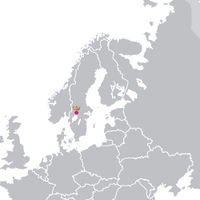Principality of Lorenzburg
This article uses a non-standard infobox to display information. Please transcribe the information to a standard infobox appropriate for the article. |
This article's tone or style may not reflect the encyclopedic tone used on MicroWiki. |
Principality of Lorenzburg Storfurstendömet Lorenzburg (Swedish) | |
|---|---|
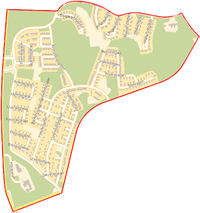 | |
| Official languages | Swedish, English |
| Religion | Secular |
| Demonym(s) | Lorenzbou |
| Government | Constitutional Paramythocracy |
• Prince | H.S.H. Prince Freï von Fräähsen zu Lorenzburg |
| Area | |
• Total | 1.1 km2 (0.42 sq mi) |
| Currency | Swedish Krona |
The Principality of Lorenzburg, or simply Lorenzburg, is a micronation founded on December 1, 2014. The nation's borders coincide with the borders of the city district of Lorensberg in the Swedish city of Karlstad. The area is approximately 11 hectares (110 000 square meters) and is contiguous with the districts ‘Rud’, ‘Kroppkärr’ and ‘Stockfallet’. The district is mostly a residential area with villas and semi-detached houses. There is also some woodland, a kindergarten and some playgrounds. The Principality is not occupying, by force or any other means, the territory of Sweden but is understood to be a a kind of ‘double exposure’ where the nation overshadows, as a parallel universe, the actual physical space of the town district in Karlstad. Lorenzburg aims to be a refuge for visionaries, free thinkers, geeks, freaks, queers, artists, scientists and all others. Anyone, anywhere, can apply for citizenship. Lorenzburg is a Constitutional Paramythocracy (from the greek "paramythos" - fairy tale). The Principality of Lorenzburg was founded with the aid of a grant from the municipality of Karlstad, and the founding of the nation is initiated as a large-scale community art project focusing on urban agriculture, collective storytelling and tourism.
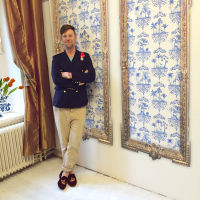
His Serene Highness, Prince Beau Freï Jean-Seraphine Baltazar von Fräähsen zu Lorenzburg is the Head of State of the Principality of Lorenzburg. Prince Freï was born on December 4, 1976 and he is the present head of the Princely house ‘von Fräähsen zu Lorenzburg’. The Prince is a great protector of the arts and the sciences and he is devoted to issues of education and human emancipation. Prince Freï himself is a trained dancer, performance artist and writer. He is also the initiator to "Princes Without Borders", an organisation devoted to charity and helping refugee children.

 History
History

2001-2009
Very little is known of the Lorenzbou history before 1965. On the 11th of December 1959 the Karlstad Municipal Housing Comity proposed to develop a woodland area situated between the districts Rud, Kroppkärr and Stockfallet. On September 1 in 1964 the Comity decided to go ahead and initiate a building project in the new district, which was to be called Lorensberg. The work to convert the woodland and to construct villas and semidetached houses continued in the years after. Today Lorensberg is a woodland residential area of approximately 1650 inhabitants.
H.S.H. Prince Freï was raised in the district and, after years of traveling and art educations abroad, he returned to found the Lorenzbou nation in December 2014.
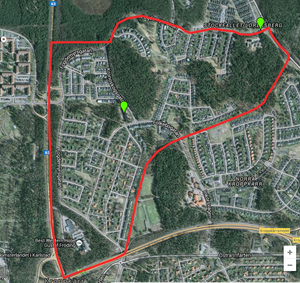

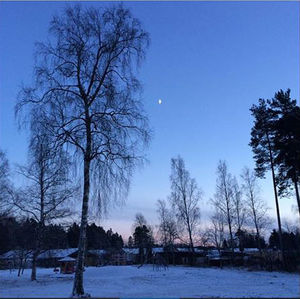

The Principality of Lorenzburg also has a "most ancient and noble" history. The nation has previously existed eternally within the parallel universe of fairy tales. The University of the Fantastic Sciences are devoted to excavating the parallel history by means of shamanistic technologies and by collective storytelling.
 παραμύθοκρατία - Constitutional Paramythocracy
παραμύθοκρατία - Constitutional Paramythocracy
The Principality of Lorenzburg is a constitutional paramythocracy (greek: paramýthi - fairy tale). The nation is governed as being a double exposure of the mundane world and the realm of fairy tales. The nation coincides with, and superimposes, the actual physical environment of the city district of Lorensberg. In this sense the nation can be seen as the "true and hidden", or spiritual version, of the area. The timeless and ethereal fairy-tale-esque quality of Lorenzburg means that it is simultaneously both "here and there". In a sense, merely invoking its name or wishing oneself there means being present within Lorenzbou borders regardless of where one is situated in the world. Hence citizenship is more a matter of identity and kinship in values rather than physical presence within the earthly borders of Lorenzburg.
In Michael Ende's The Neverending Story the very land is generated by the mythical “Child Empress”. She is the true heart of her fantasy empire. When the Empress is dying her country dies with her, and when she regains her health the country yet again blossoms. Similarly the nation of Lorenzburg is generated within The Prince, who functions as a "Lanterna Magica", and then projected outwards into our world. The country and the Prince are inseparable, or, to put it another way, they are one and the same. In Ende’s book the empress “reigns” but she doesn’t “rule”. All beings, whether they are ugly; beautiful; Intelligent; Stupid; “Good”; “Bad”; bright; dark, are equally welcome in Fantásien – the Child Empress’ realm. Similarly Prince Freï welcomes all people regardless of background, ability, ethnicity, religious belief, sex, gender, sexuality or any other characteristics to his kingdom. The only criterion for citizenship is that citizens adhere to the “sacred” command not to disturb or destroy someone else’s opportunity for creativity, play or personal growth. The Prince doesn’t exercise any real power over his citizens even though some citizens may choose to follow his decrees. The relationship between the Prince and the citizens is a mutual handshake, they legitimize each other, and the contract is valid only as long as both parties think that it is valuable. The Prince’s function is to be a ‘primus inter pares’, first among equals, and as such his ultimate function is to be the ceremonial bearer of the mythological ‘matter’ of the nation and the people as well as ensuring their welfare and to champion the enlightenment ideals. Lorenzburg will exist as long as the Prince, or an appointed heir, reigns. If none is to be found the nation will cease to be.
Lorenzburg is situated in a speculative "what-if" quantum space. Ordinary yes/no or real/imagined dualisms are suspended in favor of a third option of non-choosing a set reality. Because of this quantum quality the nation fluctuates between the mundane and the fairy tale dimension. Similarly citizens, too, may have dual aspects of the mundane and the fantastic.
Lorenzburg is a democratic nation. This means that all citizens have the same right to vote and that all votes are of equal worth. Citizens are expected to engage in the running of the nation by participating as ministers or representatives in the government.
Paramýthocracy shouldn't be confused with Mythocracy - a contemporary, but not widely spread, concept "to describe the role of Propaganda in Technology-Driven Democratic Societies".
 National Symbols
National Symbols
One of the most prominent symbols of Lorenzburg is the Crowned Pea. This is a reference to the fairy tale Princess and the Pea by H.C. Andersen. In Lorenzburg the Pea is revered as the true protagonist of the famous fairy tale. It is a reminder that also that which is small may be the cause of greatness.

2001-2009
The primary national symbol of Lorenzburg is the flag called Oriflamme - the Flame of Lorenzburg. The Oriflamme (Flame of Lorenzburg) is the red and gold flag of Lorenzburg. In the flag the symbolic golden crowned pea can be seen against a red background sprinkled with a pattern of small crowns of gold. The flag may also be carried as a standard, in which case a version with three tongues is always used. The standard has a border of gold (or yellow) and a tassel of blue silk at the end of each tongue. One may also use a larger version of the standard in lieu of the simpler version of the Loreiflamme on a flagpole. The Flame of Lorenzburg, is inspired by the ancient, but never used in modern times, French flag Oriflamme.
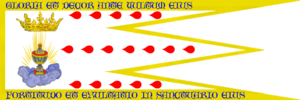
2001-2009
The Sacrivexillum is the personal standard of the Prince of Lorenzburg. It is a white standard of three tongues trimmed in gold and it depicts a vessel of anointing oil, crowned and resting on a cloud. From the vessel flows drops of fire or blood, seven drops down the middle tongue and five on the tongues on either side. The standard bears the text in Latin: 'gloria et decor ante vultum eius fortitudo et exultatio in sanctuario eius' (Splendor and majesty [shines from his face]; strength and beauty are in his sanctuary.)
The symbolism of this standard is referencing the Prince as source and fount of the majesty of Lorenzburg. From him flows the mysterious anointing, as droplets of spirit, which animates the land. But the Prince and the Land are one, and their existence are mutually dependable upon each other and so the mystical anointing must flow in both directions in a bi-latteral relationship.

The Lorenzbou national Coat of Arms shows a wealth of symbolism. The actual arms consists of a quartered shield showing the mythological crowned pea of Lorenzburg and an eagle holding a scepter and a pomegranate. The arms of the Princely House von Fräähsen zu Lorenzburg is placed in the middle. The Princely arms shows a peacock holding a pea in one of its talons and the constellation "Corona Borealis" (Northern Crown) and an actual crown are depicted against blue. The national coat of arms is flanked by an angel and a wild man as shield holders. They symbolize the importance to balance culture and nature.

The Holy Chrismarium is one of the Regalia of Lorenzburg. It is a ceremonial vessel used to store the Chrisma Principate (coronation oil) used in various Lorenzbou ceremonies. The vessel, of sterling silver, is made in the shape of a peacock, one of the Lorenzbou Princely symbols. The reigning monarchs of Lorenzburg anoint themselves daily in a renewed commitment to the nation and her people. The holy oil is also used to anoint newborn infants of the Princely family as well as in the ancient ritual of healing, known as the Kings Touch. Inscribed around the base of the vessel is a section from Exodus 29:7: Et oleum unctionis fundes super caput eius atque hoc ritu consecrabitur - You shall take the anointing oil and pour it on his head and anoint him.
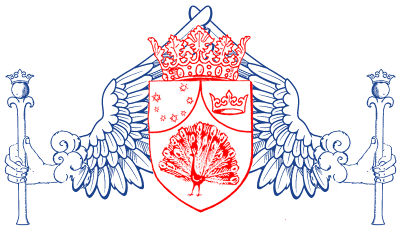
 Education
Education
The five Universities of Lorenzburg:
| University of the Natural Sciences | University of the Humanities | University of Dream, Vision and Magick | The Music Innovatory | The Academy of Arts and Architecture |
|---|---|---|---|---|
 |
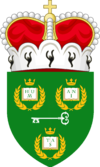 |
 |
 |
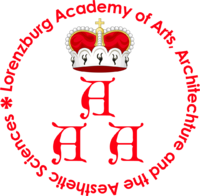 |
The Principality of Lorenzburg aims to offer a broad range of educations to its citizens. The five universities cover a broad spectrum of disciplines, ranging from the Natural Sciences, to the Arts via the more abstract "Fantastical Sciences" of Dream, Vision and Magick.
Lorenzburg aims to gather visionaries, geniuses, innovators and all other people who think outside the box. The University of the Natural Sciences and Innovation is an active resource in the careful and sustainable use and development of the intellectual and innovative capital in Lorenzburg.
The disciplines knowns as “The Humanities” are important to Lorenzburg. Among these are ethnology, history, history of ideas, aesthetics, art history, rhetorics, languages, literature, sociology, pedagogy, cultural anthropology, psychology and religious science. The individual’s positive understanding of herself and her context is understood to be the very cornerstone for a healthy and innovative society.
Lorenzburg recognizes the importance of vision and creativity, and the University of Dream, Vision and Magick seeks to cultivate these faculties in the students. The University seeks to identify and to amplify the conditions that create truly visionary people.
The Music Innovatory is the Lorenzbou version of the Music Conservatories, Academies or Music Universities of other nations. Lorenzburg recognizes that art and culture have important roles to play in society. Vision and agency will stagnate without a broad and deep hotbed where ideas can germinate and come to flower. The Innovatory is a place where tradition is preserved and kept alive but, more importantly, it is a place for experiments and the development of new sound and music.
The Academy of Art, Architecture and Aesthetic Sciences gather all aesthetic disciplines, except music, under one banner. In Lorenzburg the arts are understood as tools for breaking new cognitive and cultural ground. The arts are sciences of the senses. The academy is dedicated to innovation in the arts.
Culture and Traditions

The Lorenzbou culture is celebratory in nature. Life, nature and community are seen as sources of beauty and happiness. The Lorenzbou guild of St.Knut is an important bearer of tradition and heritage. Originally the guilds of St. Knut (St. Canute) where spread in northern Europe. The guilds all had a religious character and gave the members solidarity and protections in times when the legislative system was weak. Most of the S:t Knut’s guilds had duke Knut (Canute) Lavard as their original patron saint; he had been canonised by the Pope in 1169 and they probably originated during the period 1170 and up to 1250. The guilds also served as a local defense or Home Guard and therefore arranged regular archery exercises and contests. The guild of St. Knut still practices the ancient tradition of “Parrot” shooting on targets shaped as parrots.
The contemporary guilds are primarily of a social character that celebrate the traditions and arrange yearly dinners and dances as well as other social activities. The guild also engages in some charity work directed towards the young and elderly. Membership is for life and there is only a one-time small membership fee to be paid at the first reception. The Saint Knut’s guilds are unusual as they, from the beginning, welcome both men and women as members.
The primary celebration, since ancient times, is on the feast day of Saint Knut on the 13th of January or on the nearest saturday. At the reception deceased brothers and sisters are commemorated and new members introduced. The guild also arranges the traditional annual parrot-shooting in the end of May or in the beginning of June.
 Lore and Legends
Lore and Legends
The Oracle of Mons Caprifolium
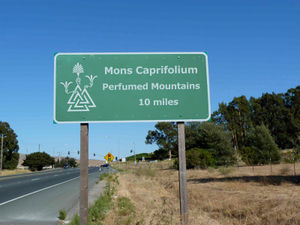
According to ancient legend a Lorenzbou Oracle resides in the Perfumed Mountains or "Mons Caprifolium" somewhere in the world. Any citizen may contact the Oracle, however not much is known of him save his name: Nancyphant. The Perfumed Mountains has an etherial connection to the Principality of Lorenzburg, possibly through the influence of the constellation Corona Borealis (Northern Crown).
The ”Perfume” of the mountains
The unique geothermal conditions of Mons Caprifolium cause a constant mist of fragrant fumes to seep out of the mountainside. This phenomenon is caused when hot vapors enter subterranean pockets of fossilized fragrant resins, and this creates an incense-like fragrance that envelops the mountain peaks. The Perfumed Mountains are also home to many species of flowers and flowering trees and bushes that give off their own special perfume. The abundance of Honeysuckle (Lonicera caprifolium) in the mountains led to them being named ”Mons Caprifolium” when they were first described in 1746 by the aging French explorer and Jesuit priest Pierre François-Xavier de Charlevoix.


Nobility

The Shield's Guild, the House of Nobility of Lorenzburg, is the official institution of the Knights and the Nobility. Membership in the Shields Guild is open to anyone who has been knighted or created a title. Also "naturalized" nobility can ask to be listed as nobility in the Principality however in order to be accepted they must be able to provide the necessary proof of prior nobility in another country.
An individual who has performed outstanding services to the nation can be awarded a noble title as recognition of the deeds done. These can be, for example, great actions of structural, administrative, cultural, economic or innovative value to Lorenzburg. One who has done particularly heroic deeds can also be knighted.
In Lorenzburg nobility always comes as recognition to the deserving. The Prince shall not arbitrarily grant titles on basis of personal friendship or favors. The grant of a title is a supreme recognition of an individual's valued services. It is also expected that any descendants holding the same title shall continue to serve the nation in the future.
The actual ceremony of knighting or granting titles is a solemn occasion of ancient origins. Each noble rank has their own version of the ceremony and the protocol is designed to give the newly appointed knight or nobleman/woman a memorable experience. A council of representatives of the nobility is elected every second year. A person of higher rank doesn't necessarily have precedence in the elections.
The Principality recognizes three classes or ranks of nobility:

1. Earl/ Countess
This is the highest noble title of the Principality and the grant admits the title to the apointee and their ascendants. The title of Earl is an armigerous title, meaning that the Earl is expected to compose a coat of arms for their family under guidance of an experienced heraldic artist. The coat of arms is then used by the Earl/Countess, their children and all their descendants. The coat of arms and the family name will be listed in the annals in the House of Nobility.

2. Baron/ess
This is the second highest noble title of the Principality and the grant admits the title to the apointee and their ascendants. The title of Baron is an armigerous title, meaning that the Baron is expected to compose a coat of arms for their family under guidance of an experienced heraldic artist. The coat of arms is then used by the Baron/ess, their children and all their descendants. The coat of arms and the family name will be listed in the annals in the House of Nobility.
3. Knight of Lorenzburg

The title of Knight of the Spur (latin: Eques Calcaris), is wrongly seen as the least exalted of the nobility. It is a personal noble title for life. The title is not inherited by the Knight's descendants and the title is not armigerous. This means that even though the Knight may have a family coat of arms it isn't listed in the Shields Guild in the House of Nobility. The title of Knight isn't hereditary but it holds a special position within the peerage. The Knights of the Spur are recognized as a class of very virtuous people and they are the only ones that are allowed to "give as they receive" upon being ritually slapped by the Sovereign in the knighting ceremony.
Crowns of the different ranks of Lorenzbou nobility:
| Princely Crown | Earl's Coronet | Baron's Coronet |
|---|---|---|
 |
 |
 |
Example of Letter Patent granting arms and the title of Baroness:
| An example of a Lorenzbou grant of the title Baroness (first page) | An example of a Lorenzbou grant of the title Baroness (second page) |
|---|---|
 |
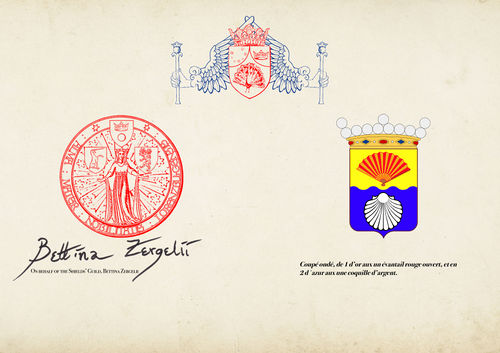 |
 Orders and Decorations
Orders and Decorations
Some of the orders of the Principality of Lorenzburg

The Principality’s highest and most noble order is inspired by the nation’s flag – Loreiflamme, the Flame of Lorenzburg. The Order is predominantly awarded to heads of state but also to citizens or others who have done a great service to the Principality.

In Lorenzburg we do not believe in violence. We do however realize that some values must be protected. Human Rights, everyone’s right to education, to freedom, to happiness… these values are sacred to us. We also see that people are maltreated and persecuted in many places across the world.
In Lorenzburg we have no “Order of the Sword” or similar to celebrate the hunger for “glory”. We recognize no glory in the killing and maiming of other people. We think it takes far more courage to protect and defend that which is small and fragile than it takes to conquer others’ lands, possessions and bodies in battle. Anyone who performs great deeds of protecting Lorenzburg, other people and aforementioned values, may be awarded the order of St. Johanna the Protector. It borrows its name from the saint Joan of Arc. The order exists in two ranks. The Commander’s Grand Cross consists of a silver gorget with red enamel and the crowned golden pea of Lorenzburg surrounded by crowns. This is a direct reference to the nation’s flag. The cross itself consists of a double compass rose in red and an oval medallion with the portrait of St. Johanna. The knight’s cross is a simple compass in red enamel with the portrait of St. Johanna the Protector.

The insignia of the order of St. Isaac consists of a pearl earring, symbolizing tears and compassion, and a breast star with a portrait of St. Isaac himself.
Doctors, healers, charity workers or volunteer-workers may be awarded the order in recognition of their compassionate deeds for other people. St. Isaac is known to have written that the ability to shed tears is one of the signs of the maturation of the soul.

The Order of St. Elmo (class 2) is a stylized compass rose in red and white, and with a center depicting the mythological ship “Argo”. The ship’s mast is a torch as a reference to the weather phenomenon called St. Elmo’s Fire as well as a symbolic reference to intellectual enlightenment and piercing the shadows of ignorance. The Order of St. Elmo (class 1) is a double compass rose accompanied by a breast star with a portrait of the saint.
The order is awarded for great services within seafaring (trade and exploring) and education. The ship and the torch symbolize the possibility to navigate by oneself or to safely guide others through the rough waters of ignorance.

“You shall take the anointing oil and pour it on his head and anoint him. The desert and the parched land will be glad; the wilderness will rejoice and blossom. Like the crocus.”
The most Subtle and Mystical Ordo Chrisma Principate may only be awarded to anointed and crowned Monarchs. It is understood that the sacrament of the Chrisma Principate (Coronation Oil) is an enactment of a spiritual authority, and a commitment to uphold the truest and most noble values of chivalry, in service of the absolute emancipation of all humans everywhere.
The insignia is a mirror of the Sacrivexillum, the personal standard of the Prince of Lorenzburg. It is a simple compass of white enamel, adorned with red droplets. The centre medallion bears a crowned vessel of anointing oil, resting on a cloud. Ribbons of blue enamel carries the text in latin: "gloria et decor ante vultum eius fortitudo et exultatio in sanctuario eius" (Splendor and majesty [shines from his face]; strength and beauty are in his sanctuary.)
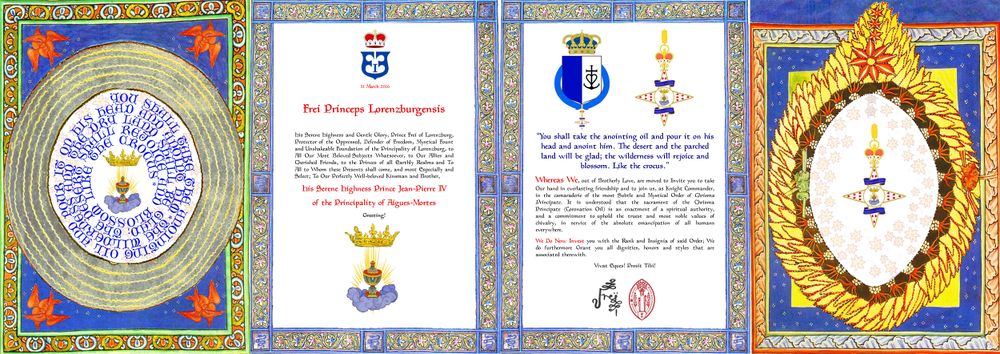
 Holidays
Holidays
| Date | Name | Remarks |
|---|---|---|
| 1 January | New Year's Day | World peace confraternization |
| 13 January | Saint Knut's Day | Traditional Holiday |
| 2 February | Festival of Lights | Chasing away winter |
| 21 March | Spring Solstice | Marks the height of Spring |
| 1 April | April Fool's Day | |
| 30 April | Festival of Embraces | Celebrating, love, beauty and attraction |
| 1 May | May Day | International Workers' Day |
| ca: 25 June | Midsummer's Day | Traditional Holiday |
| 1 December | Emergence Day | Lorenzburg Foundation Day |
| 4 December | St. Barbara's Day | Prince Freï's Birthday |
| 13 December | St. Lucys Day | Traditional Holiday |
| 21 December | Winter Solstice | Traditional Holiday |
Values of Lorenzburg
The nation shall promote the human rights to emancipation and wellbeing. Lorenzburg shall be a a role-model in terms of neighborliness with the surrounding nations, a wise use of natural resources and providing the citizens with means for a good and true life in accordance with personal conviction and talent.
- Lorenzburg shall promote peace, understanding and freedom within the international community.
- Lorenzburg encourage collective and individual acts of solidarity both locally and globally.
- Lorenzburg shall be a benefactor and protector for the furthering and diversity in the arts and the sciences.
- Lorenzburg shall be a spiritual refuge for any individual who wants to deepen their sovereign right to a unique and personal expression.
- Lorenzburg shall be a powerful voice in the fight against homophobia, racism, sexism, religious fanaticism, aggressive nationalism.
- Lorenzburg shall champion every human being's right to safety, food, love, freedom and education. It is our firm understanding that resources need to be distributed more equally throughout the world.
- The environment needs to be protected and celebrated as a source of life and resources. We must aim to live responsibly, both individually and as an international community.
 Lorenzburg in the inter-/micronational community
Lorenzburg in the inter-/micronational community
The Principality of Lorenzburg aspires to have an active foreign politics with extensive bi- and multilateral collaborations both locally and globally. The Nation welcomes official diplomatic relations with countries that are based on democratic and humanistic values of freedom of speech and the right to live and love safely. Lorenzburg will enter diplomatic relations with any nation that adopts, and adheres, to the Universal Declaration of Human Rights. While this is not a perfect document it is a genuine attempt at protecting the rights and liberties of all human kind. Lorenzburg accept the declaration in this spirit. Nations that are engaged in war, religious proselytizing or that have homophobic or racist policies will not be considered as potential partners for diplomatic exchange.
Lorenzburg currently has official diplomatic relations with these nations:
| the Kingdom of Gaerstania | Consulat of Surland | Principality of Aigues-Mortes | Archduchy of Mimas | Kingdom of Viper | Kingdom of Smyrna | Popular Union of Occitania |
|---|---|---|---|---|---|---|
 |
 |
 |
 |
 |
 |
 |
| Royaume de Cumagne | Principality of Hashima | Grand Duchy of Letzembourg | Royaume de Nova Francia | Kingdom of NorAuthwik | Kingdom of Ruthenia | Principality of Pontinha |
|---|---|---|---|---|---|---|
 |
 |
 |
 |
 |
 |
 |
| Kingdom of Emden-Holstein | Kingdom of Sabia and Verona |
|---|---|
 |
 |
Lorenzburg recognizes all member states of the Unated Nations.
Lorenzburg recognizes the rights of all indigenous people to govern themselves.
 Government and political data
Government and political data
More to come soon
People and Offices
Royalty
![]() H.S.H. and Gentle Glory (reigning) Prince Freï of Lorenzburg - full name: Beau Freï Jean-Seraphine Baltazar von Fräähsen zu Lorenzburg
H.S.H. and Gentle Glory (reigning) Prince Freï of Lorenzburg - full name: Beau Freï Jean-Seraphine Baltazar von Fräähsen zu Lorenzburg
![]() H.S.H. and Fount of Supreme Strength Prince Andreas of Lorenzburg, partner to Prince Freï
H.S.H. and Fount of Supreme Strength Prince Andreas of Lorenzburg, partner to Prince Freï
![]() H.S.H. and Ocean of Sweetness Prince Bo (Father of Prince Freï)
H.S.H. and Ocean of Sweetness Prince Bo (Father of Prince Freï)
![]() H.S.H. and Splendrous Mercy Princess Lena Birgitta (Mother of Prince Freï)
H.S.H. and Splendrous Mercy Princess Lena Birgitta (Mother of Prince Freï)
![]() H.S.H. and Everlasting Tranquil Splendor Prince Magnus (Brother of Prince Freï)
H.S.H. and Everlasting Tranquil Splendor Prince Magnus (Brother of Prince Freï)
![]() H.S.H. and Radient Profundity Princess Helena (Wife to Prince Magnus)
H.S.H. and Radient Profundity Princess Helena (Wife to Prince Magnus)
![]() H.S.H. and Heart of Noble Wealth Princess Ella (Daughter to Prince Magnus and Princess Helena)
H.S.H. and Heart of Noble Wealth Princess Ella (Daughter to Prince Magnus and Princess Helena)
![]() H.S.H. and Thundering Throne Prince Markus (Brother to Prince Freï)
H.S.H. and Thundering Throne Prince Markus (Brother to Prince Freï)
![]() H.S.H. and Celestial Luminosity Princess Amanda (Wife to Prince Markus)
H.S.H. and Celestial Luminosity Princess Amanda (Wife to Prince Markus)
Officials
![]() Bettina Zergelii - Chief Herald of Lorenzburg
Bettina Zergelii - Chief Herald of Lorenzburg
![]() Carl Svantesson - Lord Chamberlain & Marshall of the Realm
Carl Svantesson - Lord Chamberlain & Marshall of the Realm
Notable Nobility
![]() Margareta Hasselrot - Countess
Margareta Hasselrot - Countess
![]() Ami Skånberg Dahlstedt - The Pilgrim Baroness of the Painted Fan
Ami Skånberg Dahlstedt - The Pilgrim Baroness of the Painted Fan
![]() Anna Svensdotter - Baroness of the Stellar Flute
Anna Svensdotter - Baroness of the Stellar Flute
![]() Viktor Sandberg - Baron of Lamb and Laurel
Viktor Sandberg - Baron of Lamb and Laurel
![]() Mikael Gabrielsson - Knight of the Spur
Mikael Gabrielsson - Knight of the Spur
![]() Adrian Gindl - Knight of the Spur
Adrian Gindl - Knight of the Spur
![]() Sandra Bittman - Knight of the Spur
Sandra Bittman - Knight of the Spur
![]() Stephen Schloss - Knight of the Spur
Stephen Schloss - Knight of the Spur


